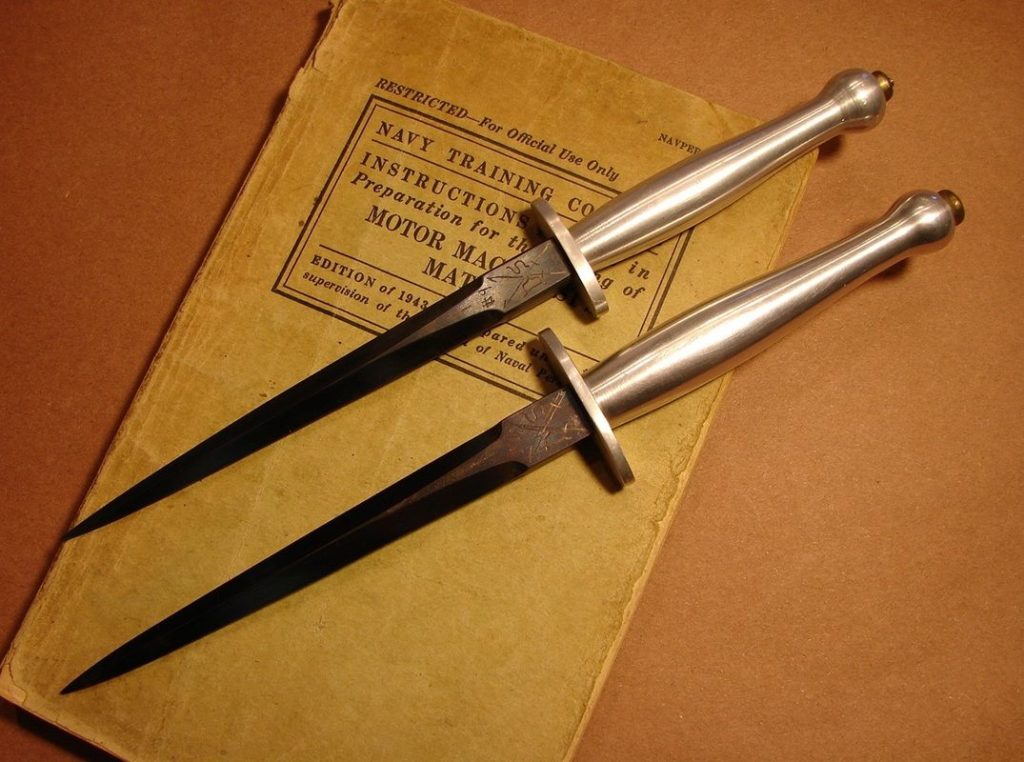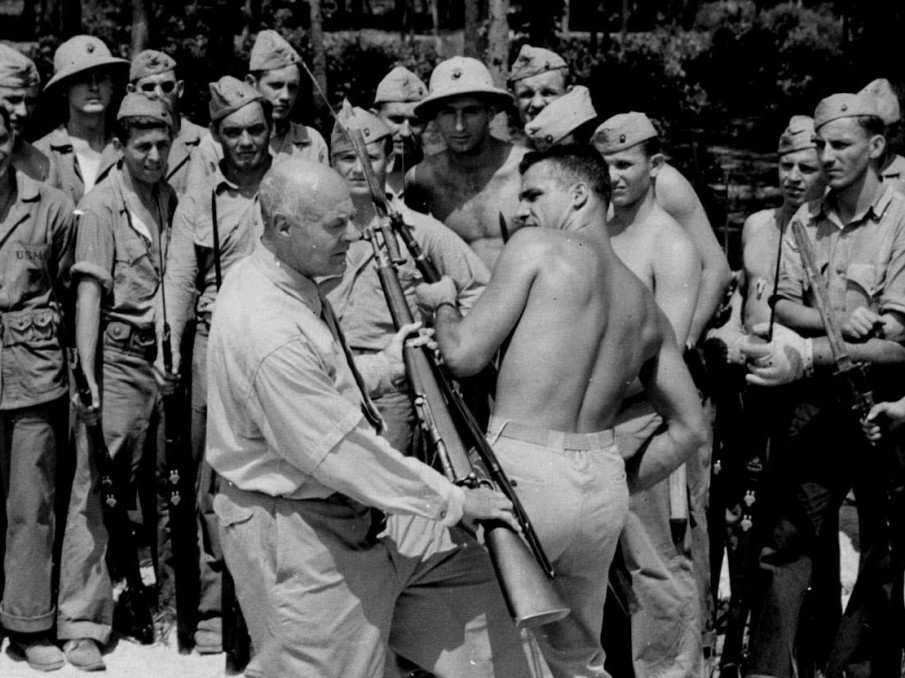World War II saw the advent of modern special operations, and thus the need for special hand-to-hand fighting skills for special operators. The foremost of these units were the British Commandos, the OSS, the First Special Service Force (1SSF), Army Rangers, Marine Raiders, and Alamo Scouts. There were others, many of whom were formed ad hoc by commanders, in special situations. William Ewart Fairbairn and Eric Anthony Sykes were the founders of modern SOF hand-to-hand fighting techniques and were key players in the development of modern close-quarters combat.
Their names are often recognized in reference to the Fairbairn-Sykes fighting knife, which they designed and was widely issued during WWII to Allied SOF units. Fairbairn and Sykes developed their expertise in hand-to-hand combat working as policemen in Shanghai in the 1920s, an overpopulated city overrun with crime and drugs. They commanded a special police unit that was tasked with riot control, Triad interdiction, and other special projects. Fairbairn and Sykes did a survey of various martial arts systems across Asia, and from that developed their own system and called it Defendu. They and their police officers tested and improved this system in thousands of documented engagements.

The purpose of Defendu was to be as brutally effective as possible. It differed from traditional systems in that it did not require years of training to attain competency. It could be taught and mastered relatively quickly. In the early days of World War II, Fairbairn and Sykes were brought back to Britain to train British SOF commandos and operatives in Defendu. Fairbairn named it “Silent Killing Close Quarters Combat Method.” (The acronym SKCQCM never caught on.) It became the standard for all British SOF personnel and was adopted by and improved upon to meet U.S. SOF needs.
Rex Applegate and Anthony Biddle were U.S. Army officers who learned and then taught Fairbairn and Syke’s system to OSS operatives at a training facility near Lake Ontario, Canada. Eventually, Applegate’s and Biddle’s hand-to-hand training spread throughout all U.S. SOF units, particularly, in the First Special Service Force and the Army Rangers.
The OSS was unique in its hand-to-hand needs in that many of its operators were women and even many of the men were not necessarily models of fitness and strength. So, speed and brutality were crucial to success and survival. Meanwhile, traditional judo, knife-fighting techniques, and bayonet drills remained the focus of hand-to-hand training for most units of the Army and USMC.
The 1st Special Service Force, the Alamo Scouts, and the Army Ranger battalions had somewhat different training, as special operations units often do.
Numerous books describe the training environments and attitudes in these units to be very adaptive and open to ideas outside normal Army and military protocols. This was due to the special needs of their missions and to the types of men attracted to such units. One such provision was sentry removal, which required stealth and quick killing skills: Neither bayonet drills nor boxing provided insights into this. Various knife, strangling, and choking techniques were devised, probably with a fair amount of Defendu influence.
Another skillset was covert infiltration of enemy lines. This was usually done at night and in squad-sized units. It required infiltrators to kill as many enemies as possible, as quietly as possible before the shooting started and the alarm was sounded. All of this was, of course, a throwback to World War I, the lessons of which had been lost during the emaciation of the U.S. military in the two decades after that war.
Nonetheless, World War II is widely considered to be the foundation and proving grounds of modern U.S. special operations.
The Post-War 1950s
The 1950s were a period of prosperity and expansion for the United States. Businesses and markets boomed. The G.I. Bill allowed millions of veterans to get college educations. Eisenhower was president and life was good. But such was not the case for the U.S. military, for which the 1950s was a period of recovery and assessment of the lessons learned from World War II. The era was also characterized by the military’s efforts to figure out the new threat: communism, and its red-headed stepchild, military insurgency.
After World War II and throughout the 1950s, every martial arts system under the sun was being taught throughout the U.S. military, especially SOF units, depending on which system the team sergeant, company 1st sergeant, or sergeant-major had a belt in. One key lesson was the need to make training harder, more difficult, more realistic. “The pit,” also known as the “Bear Pit” was created around that time. The Pit differed from other hand-to-hand pits in that it was deeper and had a less structured last-man-standing format. The Pit was usually an actual pit, between two and four feet in depth, and somewhere between 15 to 30 feet in diameter; it could be of any size.
Foxholes and fighting positions were sometimes used in a pinch. Standard hand-to-hand pits have always been between 100 and 150 feet in diameter.
Men were sent in by twos for mano-a-mano, anything-goes matches, at the end of which one man walked out and one was carried. Sometimes two teams, or squads, or even platoons, were sent into the Pit for grand-melee-like free-for-alls. The first platoon to have all members down in the sawdust, not getting up, lost.
A training field manual existed but was not much adhered to by Army SOF. It was probably more closely adhered to by regular Army units, many of which also turned overtraining to whatever martial artists there were in their ranks. There are stories of yellow-belt PFCs being put in charge of company hand-to-hand in the 82nd and 101st. Jim Stewart, an SF veteran, said,
“I was the hand-to-hand instructor for the SF Qualification Course in the 77th (Group) from 1956 to 1957. I had four demonstrators: three Hawaiian guys, two with black belts in judo, one with a black belt in karate, and a ‘street-smart’ guy from New York. We taught judo throws and falls, karate punching and kicking, and stick fighting. At the end of that segment of instruction, the students were put into the Pit. Looking back, it is hard to believe that we didn’t have more injuries or quitters.”
The Pit persisted in some units, SOF and regular, Army and Marines, through the 1980s.
In 1951, the Air Force started a judo-centric combatives program which also had influences from aikido and karate. General Curtis E. Lemay, the commanding general of Strategic Air Command, was haunted by the large numbers of airmen and pilots lost in World War II in SERE situations and in POW camps. Lemay wanted those numbers reduced in the next war and figured that better hand-to-hand skills could help to accomplish that. And thus began the Air Force search for their own combatives program, one that would eventually involve just their SOF units, which at that point did not exist.
Editor’s Note: This article, originally published in 2015, is part of a series. You can read part one and part two here.










COMMENTS
You must become a subscriber or login to view or post comments on this article.